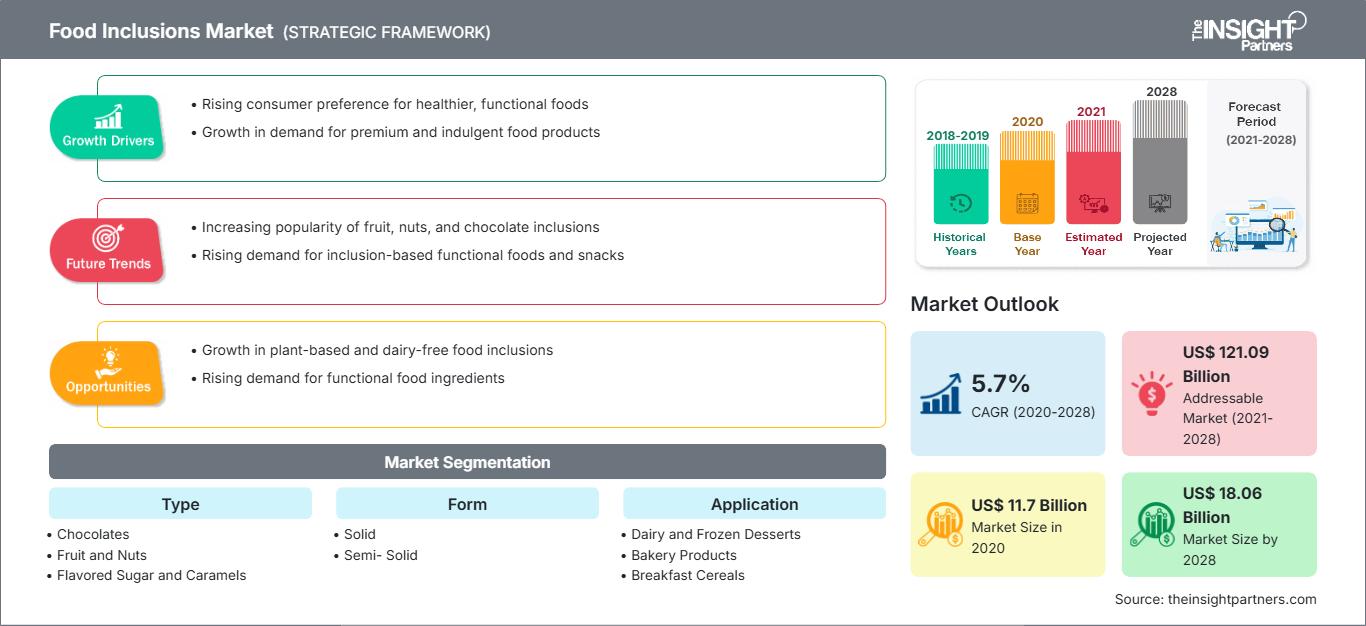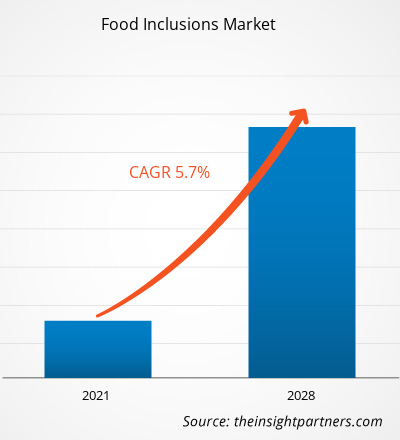2020 年,食品添加剂市场规模为 116.9554 亿美元,预计到 2028 年将达到 180.5532 亿美元;预计 2021 年至 2028 年的复合年增长率为 5.7%。
食品添加剂是添加到食品中以改善其质地或感官特性的成分。食品添加剂还可以增强食品的感官品质。食品添加剂是赋予食品价值的额外食品成分。食品添加剂越来越受欢迎,因为它们可以赋予任何所需的风味和质地,从而增加食品的吸引力。有助于赋予产品健康益处的食品添加剂也越来越受欢迎。此外,食品添加剂广泛应用于乳制品和冷冻甜点、烘焙产品、早餐谷物、巧克力和糖果产品以及许多其他产品中。
预计亚太地区的食品添加剂市场在预测期内将以最高的复合年增长率增长。该地区市场的增长主要归因于对蛋糕、面包、巧克力、果冻和冷冻甜点等包装食品的旺盛需求,预计将扩大该地区的食品融合市场。此外,饮食习惯的改变和消费者可支配收入的增加也是推动该地区食品融合市场发展的几个因素。亚太食品融合市场的其他主要参与者包括ADM、PURATOS、AGRANA Beteiligungs-AG和嘉吉公司。这些公司不断致力于创新和新产品开发,以吸引更广泛的客户。例如,AGRANA Beteiligungs-AG已在中国开设了其水果产品生产基地,该新工厂投资额达2663万美元。
自定义此报告以满足您的要求
您将免费获得任何报告的定制,包括本报告的部分内容,或国家级分析、Excel 数据包,以及为初创企业和大学提供超值优惠和折扣
食品添加剂市场: 战略洞察

-
获取本报告的主要市场趋势。这个免费样本将包括数据分析,从市场趋势到估计和预测。
由于封锁、旅行禁令和企业倒闭,COVID-19 疫情对各国经济和行业产生了不利影响。食品夹心市场对其产品趋势产生了重大影响。疫情促使消费者选择具有各种功能特性的健康食品。此外,为了打破封锁带来的常规,消费者对创新产品、体验不同烹饪体验的渴望也影响着食品夹心的市场趋势。由于水果和坚果具有健康益处,预计未来几年它们的需求将不断增长。由于人们无法旅行体验不同地区和国家的异国风味,旅行限制正在影响食品和饮料的风味趋势。例如,摩卡和芋头等亚洲风味的食品夹心在消费者中的需求激增。因此,尽管 COVID-19 疫情对食品配料的生产和供应产生了负面影响,但它对市场上的产品趋势产生了积极影响。
市场洞察:广泛的应用范围推动食品配料市场增长
食品配料是添加到不同食品和饮料中的成分或杂项,以赋予其独特的特性,例如颜色、风味和质地。一些食品配料也因其营养价值而闻名。它们应用范围广泛,包括烘焙产品、糖果、甜味和咸味小吃、冷冻甜点、饮料、早餐麦片和乳制品。这些成分以冻干、浸泡、箱冻、微干燥、单独速冻 (IQF)、喷雾干燥和全食等形式提供,并根据其应用进行选择。消费者的购买行为和消费模式以及饮食体验都受到食品质地和风味的影响,尤其是在北美和欧洲。因此,有必要根据具体应用选择最合适的食品添加物形式。例如,浸泡蓝莓用于赋予口感饱满和嚼劲,而冻干蓝莓则用于获得酥脆的口感。此外,脱水蓝莓可用于需要突出蓝莓风味的食品或饮料中。在烘焙领域,食品添加物长期以来一直被用于提升感官特性、质地、美感并提供愉悦的享受。此外,许多食品添加物富含蛋白质、必需脂肪酸、维生素和膳食纤维。树坚果、干果、香料、香草、异域水果、可可碎粒、巧克力等是烘焙产品中的主要添加物。
此外,水果、坚果和巧克力是乳制品和冷冻甜点(如冰淇淋、酸奶和奶酪)中的主要添加物类型。例如,在发酵酸奶中,主要使用甜水果作为内含物来平衡发酵酸奶的酸味。食品内含物主要以单独速冻的成分添加到乳制品和冷冻甜点中。食品内含物在冷冻甜点和乳制品中的应用具有挑战性,因为它们会极大地影响最终产品的整体质地、风味和保质期。此外,饮料制造商高度关注食品内含物,以满足消费者对天然饮料日益增长的需求。异域水果、蔬菜、树坚果和巧克力是各种饮料中消费的主要内含物。添加这些成分的饮料包括功能水、调味水、茶、啤酒、能量饮料、葡萄酒和牛奶。食品内含物的广泛应用范围是推动市场增长的主要因素。
类型洞察
根据类型,食品内含物市场可分为巧克力、水果和坚果、调味糖和焦糖等。 2020 年,巧克力占据了更大的市场份额,而水果和坚果市场预计在预测期内将实现更高的复合年增长率。巧克力夹心包括巧克力碎和块、巧克力燕麦棒、巧克力脆片、巧克力薄片、巧克力细丝和巧克力卷,它们可以为糖果、烘焙产品和糕点、冰淇淋和乳制品增添亮丽的色彩、柔和或浓郁的风味和独特的质感。此外,无论年龄和性别,消费者对巧克力味食品的需求持续增长是推动巧克力夹心市场发展的主要因素。
形态洞察
根据形态,食品夹心市场分为固体和半固体。固体夹心在 2020 年占据了最大的市场份额,预计在预测期内将实现最高的复合年增长率。固体形式的食品夹心包括碎块、巧克力薄片和巧克力碎粒、坚果、巧克力脆片和巧克力薄片。固体坚果深受消费者喜爱,广泛用于烘焙产品、糖果、乳制品和冷冻甜点、零食和能量棒、谷物食品和饮料。固体坚果夹心可以为食物增添酥脆口感或诱人的口感。
应用洞察
根据应用,食品夹心市场可分为乳制品和冷冻甜点、烘焙产品、早餐谷物食品、巧克力和糖果产品以及其他产品。烘焙产品在 2020 年占据了最大的市场份额,预计早餐谷物食品在预测期内的复合年增长率最高。烘焙产品包括曲奇、百吉饼、小圆面包、三明治、糕点、蛋糕、饼干、松饼、披萨、布朗尼等。食品夹心广泛用于烘焙产品的配料、调味、装饰和其他用途。食品配料包括切片、薄片、块状和颗粒等多种形式。食品配料全年供应,方便快捷,且能保留风味和营养成分,进一步刺激了对食品配料的需求。此外,快节奏、忙碌的生活方式促使消费者青睐方便、即食 (RTE) 且富含健康成分的食品,这推动了对添加了水果、种子和坚果等食品配料的烘焙产品的需求。
食品配料市场中的一些参与者包括 ADM、AGRANA BETEILIGUNGS-AG、百乐嘉利宝、嘉吉公司、乔治亚坚果公司、凯里集团、焙乐道、Sensient Technologies、Taura Natural Ingredients LTD 和 Meadow Foods 等。关键公司实施并购和研发战略,以扩大客户群并在全球市场上获得显着份额,这也使他们能够在全球范围内维护自己的品牌名称。
报告聚焦
- 食品夹心市场中的渐进式行业趋势,帮助参与者制定有效的长期战略
- 发达市场和发展中市场采用的业务增长战略
- 2019 年至 2028 年食品夹心市场的定量分析
- 全球食品夹心需求估计
- PEST 分析以说明行业中买家和供应商的效力
- 了解竞争激烈的市场形势的最新发展
- 市场趋势和前景以及推动和抑制食品夹心市场增长的因素
- 通过强调支撑商业利益的市场策略来协助决策过程,从而促进市场增长
- 食品夹心市场规模在不同的节点
- 市场详细概述和细分,以及食品夹心行业动态
- 各地区食品夹心市场规模及增长机会
食品夹心市场区域洞察
The Insight Partners 的分析师已详尽阐述了预测期内影响食品夹心市场的区域趋势和因素。本节还讨论了北美、欧洲、亚太地区、中东和非洲以及南美和中美洲的食品夹心市场细分和地域分布。
食品夹心市场报告范围
| 报告属性 | 细节 |
|---|---|
| 市场规模 2020 | US$ 11.7 Billion |
| 市场规模 2028 | US$ 18.06 Billion |
| 全球复合年增长率 (2020 - 2028) | 5.7% |
| 历史数据 | 2018-2019 |
| 预测期 | 2021-2028 |
| 涵盖的领域 |
By 类型
|
| 覆盖地区和国家 |
北美
|
| 市场领导者和主要公司简介 |
|
食品夹心市场参与者密度:了解其对商业动态的影响
食品夹心市场正在快速增长,这得益于终端用户需求的不断增长,而这些需求的驱动因素包括消费者偏好的演变、技术进步以及对产品益处的认知度的提升。随着需求的增长,企业正在扩展产品线,不断创新以满足消费者需求,并抓住新兴趋势,从而进一步推动市场增长。

- 获取 食品添加剂市场 主要参与者概述
- 巧克力
- 水果和坚果
- 调味糖和焦糖
- 其他
食品夹心市场 - 按形式
- 固体
- 半固体
食品夹心市场 -按应用分类
- 乳制品和冷冻甜点
- 烘焙产品
- 早餐谷物
- 巧克力和糖果产品
- 其他
公司简介
- ADM
- AGRANA BETEILIGUNGS-AG
- 百乐嘉利宝
- 嘉吉公司
- Georgia Nut Company
- Kerry Group PLC
- Puratos
- Sensient Technologies
- Taura Natural Ingredients LTD
- Meadow Foods 等
- 历史分析(2 年)、基准年、预测(7 年)及复合年增长率
- PEST和SWOT分析
- 市场规模、价值/数量 - 全球、区域、国家
- 行业和竞争格局
- Excel 数据集
近期报告
相关报告
客户评价
购买理由
- 明智的决策
- 了解市场动态
- 竞争分析
- 客户洞察
- 市场预测
- 风险规避
- 战略规划
- 投资论证
- 识别新兴市场
- 优化营销策略
- 提升运营效率
- 顺应监管趋势






















 获取免费样品 - 食品添加剂市场
获取免费样品 - 食品添加剂市场